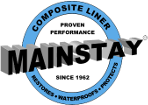Manhole Rehabilitation Resources
Existing brick and concrete sewer structures, such as manholes and lift stations, are often in need of extensive rehabilitation due to the corrosive effects of high levels of hydrogen sulfide, or sewer gas. Below is an animation that illustrates the corrosion process in a manhole.
- Surface Preparation: The rehabilitation process begins with surface preparation. Surfaces can be prepared by water blasting, pressure washing, abrasive blasting, acid etching, hand or power tool cleaning, or any combination of these. Regardless of what method or methods are used, all unsound concrete, contaminants, dirt, and debris must be removed prior to mortar application. The most common method of surface preparation is pressure washing at 4,000-5,000 psi.
- Leak Correction: A variety of methods may be used to stop leaks, including:
- Urethane Grout Injection: A hole is drilled into or near the leak site, and grout is injected to stop leaks.
- Advantage: effective
- Disadvantages: may be costly and time-consuming if there are many leak sites
- Hydraulic Cement: Water is mixed with Mainstay® ML-10 Hydraulic Cement Mortar to create a fast-setting mortar used to stop individual leaks.
- Advantages: effective and inexpensive
- Disadvantage: may be time-consuming if there are many leak sites.
- An alternative method used to stop leaks in brick manholes is to spray an initial layer of Mainstay ML-72 Sprayable Microsilica Restoration Mortar, allow it to harden, and return later to fix any remaining leaks with Mainstay ML-10.
- Advantages: cost and time-effective
- Disadvantage: requires making a separate trip to the manhole
- Mortar Application: For cases where corrosion is not present, the application of Mainstay ML-72 Sprayable Microsilica Restoration Mortar alone can smooth the substrate, increase structural integrity, and prevent inflow and infiltration (I&I). Ideally, all surfaces should be saturated (with little water remaining on the surface) prior to application of a restoration mortar. Mainstay ML-72 mortar can be applied pneumatically to the substrate using low to medium-velocity wet mix shotcrete nozzles, centrifugally using a Mainstay Mortar Spinner, or by hand using a trowel. Application thickness depends on the condition of the structure being treated and the final structural properties desired.
- Mortar Finishing: Extensive finishing is not usually required. However, most contractors will use a pool trowel (a trowel rounded on each end) to "knock down" the mortar profile followed by sponge finishing to produce a smooth, lightly textured surface. Mortar may be finished using a broom, sponge, or brush, depending on the surface texture desired. If the mortar is to be topcoated with additional mortar, it is usually recommended that the surface be finished to a coarse, broom finish. If the mortar is to be topcoated with a corrosion barrier coating, it should be finished to a smooth, somewhat grainy texture using a trowel and a sponge.
- Coating Application: In cases where a manhole has experienced or will experience corrosion, the combination of Mainstay ML-72 mortar and Mainstay DS-5 100% Solids Epoxy Coating is required to both restore and protect the manhole from future deterioration. When restoring corroded manholes using this method, Mainstay DS-5 epoxy should be applied to the mortar as soon as it is finished. Depending on jobsite requirements, it may be applied one to two hours after the mortar is finished. In any event, Mainstay DS-5 epoxy must be applied to the mortar while it is still soft enough to indent with a fingertip. Mainstay DS-5 is usually applied by the use of an airless spray pump. The coating may be hand sprayed using a spray gun, or it may be centrifugally applied using a Mainstay Coating Spinner. Other equipment, such as a whip hose, heater, or plural component equipment may be used.
- Flexible Joint Sealant Application: One significant source of inflow and infiltration in manholes occurs at the joint between the manhole cast iron frame and the concrete grade ring(s) or bricks used to bring the manhole frame to a specific elevation. Cracks and expansion around the manhole chimney may also occur if the manhole is located in an area of heavy traffic. Expansion, cracks, and leaks at this location can be easily stopped with the application of Madewell® 806 Flexible Joint & Manhole Chimney Seal.
|

